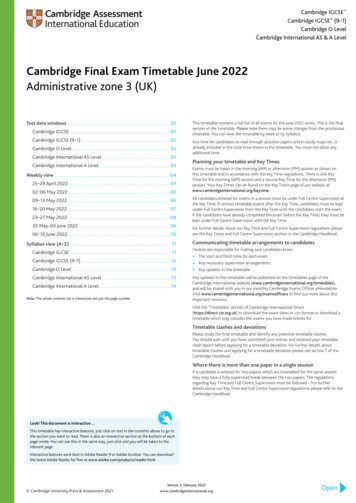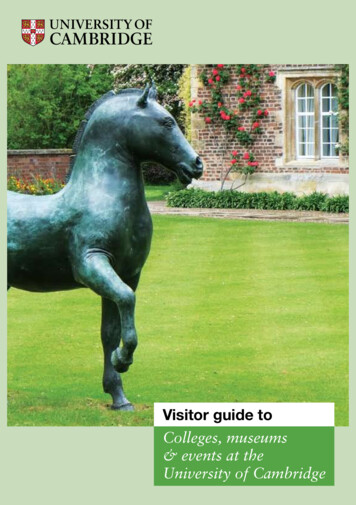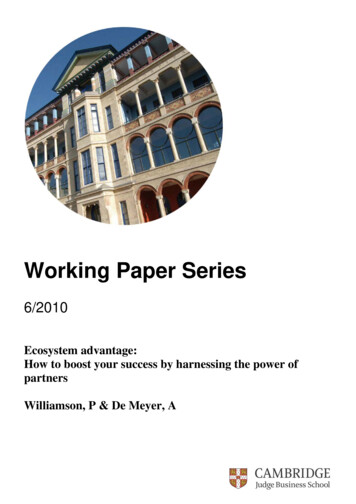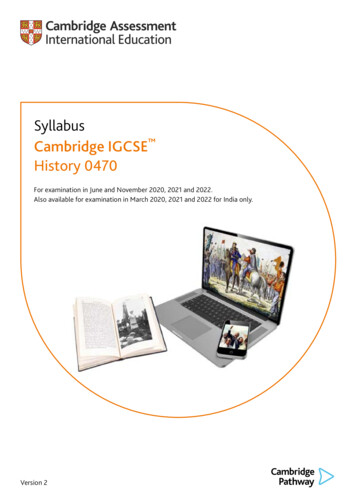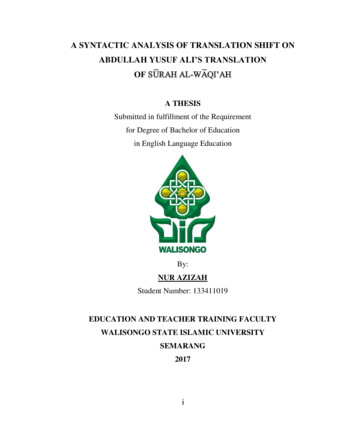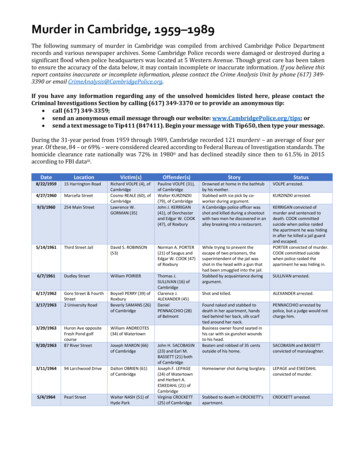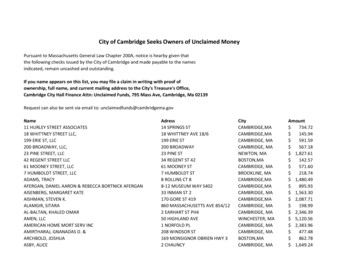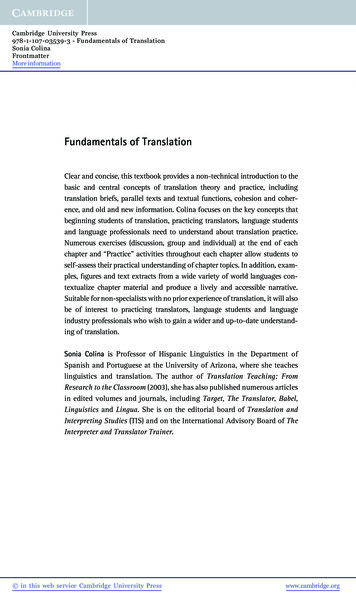
Transcription
Cambridge University Press978-1-107-03539-3 - Fundamentals of TranslationSonia ColinaFrontmatterMore informationFundamentals of TranslationClear and concise, this textbook provides a non-technical introduction to thebasic and central concepts of translation theory and practice, includingtranslation briefs, parallel texts and textual functions, cohesion and coherence, and old and new information. Colina focuses on the key concepts thatbeginning students of translation, practicing translators, language studentsand language professionals need to understand about translation practice.Numerous exercises (discussion, group and individual) at the end of eachchapter and “Practice” activities throughout each chapter allow students toself-assess their practical understanding of chapter topics. In addition, examples, figures and text extracts from a wide variety of world languages contextualize chapter material and produce a lively and accessible narrative.Suitable for non-specialists with no prior experience of translation, it will alsobe of interest to practicing translators, language students and languageindustry professionals who wish to gain a wider and up-to-date understanding of translation.Sonia Colina is Professor of Hispanic Linguistics in the Department ofSpanish and Portuguese at the University of Arizona, where she teacheslinguistics and translation. The author of Translation Teaching: FromResearch to the Classroom (2003), she has also published numerous articlesin edited volumes and journals, including Target, The Translator, Babel,Linguistics and Lingua. She is on the editorial board of Translation andInterpreting Studies (TIS) and on the International Advisory Board of TheInterpreter and Translator Trainer. in this web service Cambridge University Presswww.cambridge.org
Cambridge University Press978-1-107-03539-3 - Fundamentals of TranslationSonia ColinaFrontmatterMore information in this web service Cambridge University Presswww.cambridge.org
Cambridge University Press978-1-107-03539-3 - Fundamentals of TranslationSonia ColinaFrontmatterMore informationFundamentalsof TranslationSONIA COLINA in this web service Cambridge University Presswww.cambridge.org
Cambridge University Press978-1-107-03539-3 - Fundamentals of TranslationSonia ColinaFrontmatterMore informationUniversity Printing House, Cambridge CB2 8BS, United KingdomCambridge University Press is part of the University of Cambridge.It furthers the University’s mission by disseminating knowledge in the pursuit ofeducation, learning and research at the highest international levels of excellence.www.cambridge.orgInformation on this title: www.cambridge.org/9781107645462 Sonia Colina 2015This publication is in copyright. Subject to statutory exceptionand to the provisions of relevant collective licensing agreements,no reproduction of any part may take place without the writtenpermission of Cambridge University Press.First published 2015Printed in the United Kingdom by TJ International Ltd. Padstow CornwallA catalog record for this publication is available from the British LibraryLibrary of Congress Cataloguing in Publication dataColina, Sonia.Fundamentals of translation / Sonia Colina.pages cmISBN 978-1-107-03539-3 (hardback)1. Translating and interpreting. I. Title.P306.C65 2015418ʹ.02–dc232014042930ISBN 978-1-107-03539-3 HardbackISBN 978-1-107-64546-2 PaperbackCambridge University Press has no responsibility for the persistence or accuracy ofURLs for external or third-party internet websites referred to in this publication,and does not guarantee that any content on such websites is, or will remain,accurate or appropriate. in this web service Cambridge University Presswww.cambridge.org
Cambridge University Press978-1-107-03539-3 - Fundamentals of TranslationSonia ColinaFrontmatterMore informationContentsList of figuresPrefaceAcknowledgements1page ixxvxxviThe term “translation”: Concept, definitions and usage1.0 Introduction1.11.21.31.41.51.61.71.8Translation, translating and translation studiesPreliminary definition: Basic conceptExisting definitions of translationIn search of a definitionEquivalence and the definition of translationTypes of translation activityTranslation in a professional contextTranslation competence, translation skills and the concept oftranslationSummaryKey wordsExercisesFurther reading2The functions of translation: Functionalism2.0 Introduction2.12.22.32.4Extra-linguistic factors and monolingual textsExtra-linguistic factors and professional translationHow do situational factors affect translation decisions?Determining the extra-linguistic factors of a translationSummaryKey words in this web service Cambridge University ambridge.org
Cambridge University Press978-1-107-03539-3 - Fundamentals of TranslationSonia ColinaFrontmatterMore informationviContentsExercisesFurther reading3The functions of translation: Pragmatics3.0 Introduction3.1 What is pragmatics?Relevance for translation3.2 Grammatical functions vs. pragmatic functions3.3 Speech acts3.4 Presuppositions3.5 The non-linguistic contextSummaryKey wordsExercisesFurther reading4Texts and translation4.0 Introduction4.1 Sentences vs. texts4.2 Textual featuresTopic maintenance and continuityInformation structure of a text: Old and new InformationCoherence and cohesion4.3 Text types and genres4.4 Textual analysis, parallel texts and corporaSummaryKey wordsExercisesFurther reading5Reading and translation5.0 Introduction5.1 Reading comprehension: An interactive processTop-down and bottom-up models of reading comprehensionBackground knowledge and schemata in this web service Cambridge University ridge.org
Cambridge University Press978-1-107-03539-3 - Fundamentals of TranslationSonia ColinaFrontmatterMore informationContentsInteractive models of reading comprehensionSemantic models5.2 Reading and translationReading as interaction in translationReading and language directionality in translationReading for translation purposesSummaryKey wordsExercisesFurther reading6Social aspects of translating6.0 Introduction6.1 Language variation and changeUnderstanding language variation and change: Why shouldtranslators care?6.2 Dialectal variation6.3 Socioeconomic variation6.4 Other language varieties: Registers6.5 Register selection in translation: Linguistic and translationcompetence6.6 Translation in multilingual societiesIndividual bilingualismSocietal bilingualismSummaryKey wordsExercisesFurther reading7Translation quality7.0 Introduction7.1 The importance of quality evaluation for translation7.2 Basic concepts of evaluation in this web service Cambridge University ambridge.org
Cambridge University Press978-1-107-03539-3 - Fundamentals of TranslationSonia ColinaFrontmatterMore informationviiiContents7.3 Major approaches to evaluationExperience-based approachesTheoretical and research-based approaches7.4 Difficulties involved in evaluating translation quality7.5 A user-defined, comprehensive view of quality: Description7.6 A user-defined, comprehensive view of quality:ExemplificationThe functional-componential approach and the TranslationQuality Assessment (TQA) tool (Colina [2008], [2009])Components of the TQA tool7.7 A user-defined, comprehensive view of quality: AdaptationUsing a functional-componential tool for the evaluation ofstudent translation products226227228230231235SummaryFurther reading262262263265Answer keyGlossaryBibliographyIndex266294301305Key wordsExercises in this web service Cambridge University Press235236255259www.cambridge.org
Cambridge University Press978-1-107-03539-3 - Fundamentals of TranslationSonia ColinaFrontmatterMore informationFiguresThe author and publishers acknowledge the following sources of copyrightmaterial and are grateful for the permissions granted. While every effort hasbeen made to do so, it has not always been possible to identify the sources of allmaterial used, or to trace all copyright holders. If any omissions are brought toour notice, we will be happy to include the appropriate acknowledgements onreprinting.1.1 Determining the SL, TL, ST and TT. Credit: US Department ofpage 5Human Health and Services, Centers for Disease Control andPrevention1.2 Determining the SL, TL, ST and TT. Credit: US Department of7Human Health and Services, Centers for Disease Control andPrevention1.3 Determining the SL, TL, ST and TT. Credit: US Department of9Human Health and Services, Centers for Disease Control andPrevention1.4 Interlinguistic writing activities: The correspondence continuum.13Credit: author1.5 Resemblance to the ST: Genre141.6 Types of translation activity241.7a MT source text (circa 1990)261.7b MT raw output: Spanish target text (circa 1990)271.7c MT raw output: Spanish target text, Google Translate (2012).28Credit: Google Translate (2012)1.7d MT raw output: German target text, Google Translate (2012).29Credit: Google Translate (2012)1.8 Trados/SDL sample screen. Credit: Trados, with permission301.9 Target text: User instructions for a camera. Credit: Engrish.com301.10 Translation and the language industry32 in this web service Cambridge University Presswww.cambridge.org
Cambridge University Press978-1-107-03539-3 - Fundamentals of TranslationSonia ColinaFrontmatterMore informationxList of figures1.11 Degree of correspondence: Dental survey. Credit: VancouverCoastal Health, with permission1.12 Degree of correspondence: How to eat well. Credit: Molina HealthCare, with permission1.13 Degree of correspondence: Academic transcript. Credit: ClassicalConversations, with permission2.1 Situational features of a text: CT scan2.2 Children’s version of the Creation story. Genesis, Chapters 1–3.Credit: www.gardenofpraise.com/bibl1s.htm, accessedJune 23, 2014, with permission2.3 The Creation: Genesis 1:1–1:31, King James Bible. Credit: Genesis1:1-1:31, King James Bible2.4 How audience and purpose shape a text: Guidelines for providers.Credit: Provincial Health Services Authority, British Columbia,with permission2.5 How audience and purpose shape a text: Instructions for new parents.Credit: Mayo Clinic. r-health/in-depth/umbilicalcord/art-20048250?pg 2,with permission2.6 Situational factors change in translation2.7 Situational features for a source text, translation brief and targettext. Credit: US Department of Human Health and Services, Foodand Drug Administration2.7a Situational features for the source text2.7b Translation brief and situational features2.7c Situational features for the target text (obtained from the brief inFigure 2.7b)2.7d Target text. Credit: US Department of Human Health and Services,Food and Drug Administration2.8 Situational features for a source text, translation brief and targettext. Credit: Washington State Department of Health, withpermission, original brochure from Minnesota Department ofHealth2.8a Situational features for the source text2.8b Translation brief and situational features in this web service Cambridge University ge.org
Cambridge University Press978-1-107-03539-3 - Fundamentals of TranslationSonia ColinaFrontmatterMore informationList of figures2.8c Situational features for the target text (obtained from the brief inFigure 2.8b)2.8d Target text. Credit: Washington State Department of Health, withpermission, original brochure from Minnesota Department ofHealth2.9 Identifying situational features on the basis of the brief: English.Credit: US Department of Human Health and Services, Centers forDisease Control and Prevention2.10 Identifying situational features on the basis of the brief: Russian.Credit: US Department of Human Health and Services, Centers forDisease Control and Prevention2.11 Source text: Patient information form2.12 Norms in legal translation: A documentary, literal approach.Credit: author2.13 Write a set of instructions3.1 Pragmatic function of explicit pronoun use. Credit: AmericanHotel and Lodging Association, with permission3.2 Speech acts. Credit: author3.3 The non-linguistic context in translation: Yellow bag3.4 The non-linguistic context in translation: Refrigerator instructions3.5 The non-linguistic context in translation: Automatic guide3.6 The non-linguistic context in translation: Play button. is4.1 Non-text4.2 Informational structure in translation contexts. Credit: USDepartment of Human Health and Services, Centers for DiseaseControl and Prevention4.3 What makes a text: Coherence5.1 Reading as an interactive process5.2 Misuse of bilingual dictionary – unavailable scene.Credit: engrish.com5.3 British National Corpus: Sample of a search for word in context.Credit: British National Corpus5.4 Reading and translation in this web service Cambridge University 68169172www.cambridge.org
Cambridge University Press978-1-107-03539-3 - Fundamentals of TranslationSonia ColinaFrontmatterMore informationxiiList of figures5.5a Background information: Movie synopsis. English.Credit: www.imdb.com/title/tt1300155/?ref sr 35.5b Background information: Movie synopsis. Spanish.Credit: www.filmaffinity.com/es/reviews/1/630565.html, andothers5.6 Reading comprehension for translators (Colina [2003: 92]). Credit:McGraw-Hill6.1 Language variation and the translator6.2 Reader-oriented text. Credit: US Department of Human Health andServices, Centers for Medicare and Medicaid Services6.3 Field of activity shapes text6.4 Formality in translation: Shifts in official letters6.5 Variation types6.6 Types of bilinguals7.1 Importance of quality evaluation7.2 Example of an error-marking scale. Credit: CanadianTranslators, Terminologists and Interpreters Council, www.cttic.org/examDocs/guide.markersE.pdf7.3 Hablamos Juntos, Training Manual for Raters, Tool Kit 6. Credit:Hablamos Juntos, RWJ Foundation7.4 TQA tool cover page – Part I. Credit: Hablamos Juntos, RWJFoundation7.5 Target Language component. Credit: Hablamos Juntos, RWJFoundation7.6 Example of descriptor (1.a). Credit: engrish.com7.7 Example of descriptor (1.b). Credit: engrish.com7.8 Example of descriptor (1.c). Credit: engrish.com7.9 Example of descriptor (1.d). Credit: Hablamos Juntos, RWJFoundation.7.10 Functional and Textual Adequacy7.11 Functional and Textual Adequacy. Credit: engrish.com7.12 Functional and Textual Adequacy component. Credit: HablamosJuntos, RWJ Foundation7.13 Example of descriptor (2.a). Credit: engrish.com7.14 Example of descriptor (2.a) in this web service Cambridge University 241242242243246247248249www.cambridge.org
Cambridge University Press978-1-107-03539-3 - Fundamentals of TranslationSonia ColinaFrontmatterMore informationList of figures7.15 Example of descriptor (2.b). Credit: US Department of HumanHealth and Services, Centers for Disease Control and Prevention7.16 Example of descriptor (2.b). Credit: US Department of HumanHealth and Services, Centers for Disease Control and Prevention7.17 Non-Specialized Content (Meaning) component. Credit: HablamosJuntos, RWJ Foundation7.18 Specialized Content and Terminology component. Credit:Hablamos Juntos, RWJ Foundation7.19 Scoring worksheet. Credit: Hablamos Juntos, RWJ Foundation7.20 TQA tool cover page – Part II. Credit: Hablamos Juntos, RWJFoundation7.21 Customizing the scoring worksheet. Credit: Hablamos Juntos, RWJFoundation7.22 Purpose and object of evaluation in an educational context7.23 Competences and TQA components in this web service Cambridge University org
Cambridge University Press978-1-107-03539-3 - Fundamentals of TranslationSonia ColinaFrontmatterMore information in this web service Cambridge University Presswww.cambridge.org
Cambridge University Press978-1-107-03539-3 - Fundamentals of TranslationSonia ColinaFrontmatterMore informationPrefacePurpose of this bookOverall, Fundamentals of Translation serves the purpose of disseminating upto-date, fundamental knowledge about translation in an appropriate format fora non-specialist, broad readership.More specifically, the purpose of this book is threefold. It intends . . .1. . . . to offer a basic, easy-to-read introduction to concepts essential to translation practice.Practitioners, language and translation students, and professionals inrelated fields (managers of translators, communication specialists, etc.) needto acquire a general understanding of basic translation concepts without havingto read through pages of translation theory and scholarship or publicationsgeared toward specialists or graduate students. This need for knowledge remainsmostly unmet, as evidenced by the disconnect between the current understanding of basic translation concepts among translation scholars and that possessedby translation practitioners, students and language professionals. Many language professionals and students still refer to deeply entrenched and outdatedviews of language and of translation, at a time when research in translation hasseen unprecedented growth and advances. It is our opinion that this situation isdue not to a lack of interest but to the dearth of publications that make thisinformation accessible to wide audiences, who often feel overwhelmed anddiscouraged when confronted with books that are too long, too theoretical andtoo complex for their purposes. Along similar lines, many believe that theoryand other conceptual elements are irrelevant to practice, mostly because theyhave been presented in a manner that is too complex and too far removed fromtheir reality.2. . . . to reach out and introduce translation, in an accessible manner, toreaders who may not intend to become translators but who work in fields thatcan benefit from informed knowledge about translation. in this web service Cambridge University Presswww.cambridge.org
Cambridge University Press978-1-107-03539-3 - Fundamentals of TranslationSonia ColinaFrontmatterMore informationxviPreface3. . . . to lay the ground for a better understanding of translation amonglanguage students and other language specialists, disseminating basic conceptsand dispelling myths about translation.The idea for this volume originated, in part, while teaching applied translation courses (e.g., medical, legal, business translation). The students, at a majorresearch university in the United States, were often employed as translatorsand language professionals but had had little formal training. While thecourses were mostly practical, and the program had a separate translationtheory course (which the students may or may not have taken), it was obviousthat some basic, common theoretical framework was needed. Fundamentalsof Translation is based on some of the theoretical modules the author developed for those courses. These modules were also necessary for the eminentlypractical and professional, online certification developed by the author withfunding from an Arizona Board of Regents grant. Additionally, Fundamentalsof Translation draws on presentation materials created for professional translators, teachers and bilinguals who tested the Translation Quality Assessment(TQA) tool designed for Hablamos Juntos (see www.hablamosjuntos.org).Online training for the use of this tool required understanding of some translation/linguistic concepts with which these professionals were not alwaysfamiliar.The idea for this book also has its origins in the author’s observations as aprofessor, professional translator and small-company owner. Throughout theyears, it has become clear that many language professionals and students couldbenefit from some basic introduction to translation concepts. Students in largelanguage programs also need to understand and use professional/communicative translation in their courses.It is uncontroversial that translation means many different things to manydifferent people. Beginning translators and students come to the field withvarious misconceptions that affect their work. Lay audiences tend to have aprofound misunderstanding of translation as practiced by professionalstoday. Other language professionals have also developed their own views.Fundamentals of Translation originates out of the frequent interaction withthese professionals and students, and out of the subsequent realization thatsome common ground among language students and other language specialists is truly needed. The book attempts to do this by disseminating basic in this web service Cambridge University Presswww.cambridge.org
Cambridge University Press978-1-107-03539-3 - Fundamentals of TranslationSonia ColinaFrontmatterMore informationPrefacexviitranslation concepts and dispelling myths about translation among a broadbase of readers.TopicFundamentals of Translation covers basic concepts of translation necessary fortranslation practice and teaching. The criterion used for the selection of concepts is their centrality to the principled practice of translation, keeping in mindthe needs of a general audience. Students of translation often need to know, forinstance, about translation briefs, parallel texts and textual functions, cohesionand coherence, old and new information, etc. The book also includes basicconcepts of language and linguistics that are relevant for translation practice.By means of definitions, short explanations and simple examples, Fundamentalsaddresses and develops the answers to such questions as: What does a beginning student of translation, focused on practice, need toknow conceptually? What does a practicing translator, in particular if he/she does not have aformal education in translation, need to know to be able to operationalize,formalize and discuss his/her practice? What does the language student interested in understanding translation (asvs. grammar translation, i.e., translation as a language exercise) need toknow? What do language professionals, who may not want to become translators,need to know to understand translation as a form of cross-linguisticcommunication?Fundamentals of Translation can also be conceptualized as a basic collegelevel textbook about translation concepts and about the content knowledgeneeded to practice translation in the twenty-first century. It is not intended,however, as an overview of all topics in the field; in fact, comprehensivenesswill be sacrificed at times in order to attend to the needs of a wide, lessspecialized audience.In describing what this book is about, we believe it will be useful to explainhow it differs from current books on the market and what makes it unique. in this web service Cambridge University Presswww.cambridge.org
Cambridge University Press978-1-107-03539-3 - Fundamentals of TranslationSonia ColinaFrontmatterMore informationxviiiPreface1. Fundamentals of Translation is a book in the area of applied translationstudies and translator education, rather than translation theory or translationstudies per se.As we will see in Chapter 1, translation studies is the research and scholarlyfield that studies translation and related phenomena. Books like Munday (2012),Gentzler (1993), (2001) and others are about translation studies. Their goal is tointroduce translation studies research to researchers, graduate students oradvanced undergraduates who plan to do research in the field. Many conceptsand ideas included in Fundamentals of Translation have their origins in the workof translation scholars, and can be found and studied in depth in the translationstudies literature, including the aforementioned textbooks. Yet, Fundamentalsdiffers from those books in that it is written for readers whose primary goal is tolearn about translating and interpreting; in reading Fundamentals readers willlearn concepts that originated with translation studies, but they will not necessarily have to know about how this knowledge developed and how it came to be.Fundamentals attempts to bridge the divide between the scholarship and theoryof translation, on the one hand, and the practice, on the other, by developingapplied knowledge and concepts that are pertinent to the practice.A good parallel can be established with Second Language Acquisition (SLA)and foreign-/second-language textbooks. Although the latter depend on knowledge in SLA, they do not teach students about SLA, but rather about languagelearning/teaching. Fundamentals of Translation is, of course, slightly different, inthat it does not focus on translation practice (language books are about learning/practicing the language), but on the concepts behind the practice.Another example to illustrate the differences between a translation studiestextbook and Fundamentals of Translation concerns the field of general linguistics: Graduate-level textbooks in linguistics tend to summarize theories (generative, structuralist, functionalist) and specific data analyses. They alsoteach students how to do linguistic analysis. By contrast, an undergraduateintroductory textbook on linguistics (cf. Hualde et al. [2010]) does not introducetheories, but describes and explains content and current knowledge (whatphonemes, allophones, speech acts, rewrite rules, phrase structure rules, etc.are). Fundamentals attempts to do for translation something similar to whatHualde et al. (2010) does for (Hispanic) linguistics. in this web service Cambridge University Presswww.cambridge.org
Cambridge University Press978-1-107-03539-3 - Fundamentals of TranslationSonia ColinaFrontmatterMore informationPrefacexix2. Fundamentals of Translation is a book about basic concepts of translation,rather than a manual of translation techniques, strategies or tips.Therefore, it is not meant to teach the practice of translation directly but toexplain basic concepts that often remain unexplained in practice-oriented courses.In other words, the focus is on conceptual issues that facilitate the teaching,understanding and practice of translation. The accompanying exercises aremeant to help with the understanding of these concepts by providing for a moreinteractive approach. They are not intended to offer translation practice.3. Fundamentals of Translation is language-neutral (i.e., it is not languagespecific), and it has a non-literary focus, although the concepts presented arerelevant to all translation activity.Audience and coursesFundamentals of Translation is for a broad readership, including translators andstudent translators, but also can include language students, teachers and professionals who are not translation specialists and/or who may not plan to pursuetranslation as a career. It relies on a view of translation as a form of mediation, across-linguistic communicative pursuit, which is relevant, at least at the general,non-specialist level, to all language professionals.In more specific terms, Fundamentals is primarily for: undergraduate students enrolled in courses/certificates in translation, in particular for those who have not had major exposure to translation studies and/or to the theoretical concepts behind the practice translation practitioners/professionals bilinguals language learners language teachers linguists and linguistics students professionals in language-related or linguistically involved fields (communication specialists, business professionals, health-care professionals).No specific level of proficiency in any particular language is required, other thana basic understanding of language and language structure in general. in this web service Cambridge University Presswww.cambridge.org
Cambridge University Press978-1-107-03539-3 - Fundamentals of TranslationSonia ColinaFrontmatterMore informationxxPrefaceFundamentals of Translation explains basic concepts of translation to all ofthe above groups in what we believe is the right proportion to address theirshared needs. In so doing, this book attempts to cover a common conceptualground shared by these constituencies, while making the case that translation(in the broader, less specialized sense presented here) is relevant and pertinent tothe professional and academic lives of all these readers.For (beginning) students of translation, Fundamentals of Translation providesa basic framework for discussion of translation processes and products, obviating the need for extensive and complex readings on theory; the book helpslanguage learners and teachers to integrate translation concepts into theirlanguage and teaching experiences through a wider and up-to-date vision oftranslation, allowing them thus to learn about this related activity and possiblecareer paths. Under this view, translation is introduced earlier in the languagelearning curriculum, because it is not considered as the exclusive realm ofbalanced bilinguals. Bilinguals and professionals, already in possession oflanguage skills or translation experience, will find in the book the conceptualframework that will help them to inform their practice and their languagecompetence. Similarly, professionals in language-related or linguisticallyinvolved fields (communication specialists, business professionals, health-careprofessionals) will acquire a broader, more flexible understanding of theirprofessions and of the concepts at the intersection with other languagecareers/professionals. Finally, linguists and linguistics students will find inthis book what they need to understand translation as a communicative activity,as opposed to a language or glossing exercise. Overall, Fundamentals bridges thedivide between theory and practice in translation by translating theoretical andempirical findings in translation studies and relevant fields to the day-to-dayconcerns of the described readerships.Courses for which the book is intendedA significant port
Fundamentals of Translation Clear and concise, this textbook provides a non-technical introduction to the basic and central concepts of translation theory and practice, including translation briefs, parallel texts and textual functions, cohesion and coher-ence, and old and new information. Colina focuses on the key concepts that



